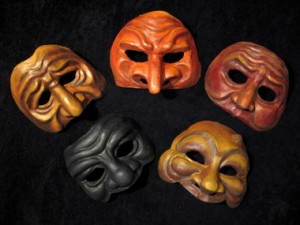Commedia Acting Tip: Animate the Inanimate.
 When you are performing as a puppet, or (for commedia) as a masked character– it’s important to remember that the mask on your face is inanimate. It is made of leather or papier mache or some other fixed material that has a fixed expression, a fixed architecture. Despite that, your character is alive, and changes emotions, sometimes at a quite rapid rate. And you need to express those changes. So the question is: how do you reconcile the two? How do you animate the inanimate?
When you are performing as a puppet, or (for commedia) as a masked character– it’s important to remember that the mask on your face is inanimate. It is made of leather or papier mache or some other fixed material that has a fixed expression, a fixed architecture. Despite that, your character is alive, and changes emotions, sometimes at a quite rapid rate. And you need to express those changes. So the question is: how do you reconcile the two? How do you animate the inanimate?
I can’t teach a whole set of mask/puppet animation classes over the internet, but I’ll give you 4 tips to think about as you rehearse your work. You can practice these using a stuffed animal or even your hand (or of course a mask). It can help to work in a mirror, although some actors prefer not to, and like to use their mind’s eye instead. You can also put your hand in the mask itself, and use that.
Masked performance is a technique, and it takes time to get good at the technical elements at it. Keep on practicing, and ask knowledgable people to watch the mask and give you critique.
1) USE YOUR BODY
Since the mask doesn’t change, your body is going to have to. You’ll need to express the emotions that your character is having with your knees, your torso, your shoulders, your hands, and everything else you possess in relation to the mask.   Change the context that the mask is in, and the sculpture of the mask (and thus it’s emotion will seem to change.   Since most commedia masks are half-masks (mouth free so you can talk) you may gain a whole new set of jaw muscles and jaw flexibility.
2) KEEP THE MASK FOCUSED
To follow the thinking of the mask, we the audience need to follow where the mask looks, so that we know and see what it is seeing. If there are three characters on stage, and your character is speaking to one of them, make sure the mask (and not necessarily you) are looking at them. Depending on the architecture of the mask, you may think that you are over-exaggerating or indicating where you are speaking or looking, but it’s better that you feel a little awkward and the audience is clear what’s going on onstage then vice versa.
3) MASK TAKES TO THE AUDIENCE.
After you finish speaking to your partner, do a mask take to the audience. What this means is, to bring the mask (but not the body) so that it is facing the audience. and then freeze the mask for a second. This accomplishes two things. It lets the audience know that you are finished speaking, and that you are now “listening” as we can see your mask listening. It also throws the focus to your partner, because you’ve stopped, and they have hopefully started. And by “checking in” with the audience, you give them a visual image to remember, so that when you change emotions later, they can see that your visual image also changed. (It did, didn’t it?)
4) KEEP THE MASK MOVING (A LITTLE)
You don’t want to be distracting, but you want to keep the mask alive, and to do that, you need to keep it moving.  A slight tilt of the head, a change of the jaw, a tiny movement of the ear should be sufficient.  Don’t distract or steal focus from your partners, but don’t wear the mask like a hat. Every movement you make should imperceptibly start with the mask first. And even the tiniest movements every once in a while serve as a reminder that the mask is moving, that the mask is alive.
While it’s not commedia, I think Paul Louis’s demonstration on e-how gives a good example of using the above techniques. He’s using it for puppets, but the ideas and goals are mostly the same. (This video below is a culmination/demonstration of all of his puppet manipulation techniques– you can follow the series in RELATED VIDEOS to see the rest of them if you are interested.)
Check out how he the performer throws focus to the puppet with his eyes, and how the puppet takes the focus when he needs to. Also, at the beginning of his speech, notice how the puppet starts to watch and pay attention to him talking. It’s small, but it’s definitely perceptible.
Demonstration of Techniques Used in Puppet Theater: Tips for Puppeteers — powered by eHow.com

Pingback: Commedia Characters: The Innamorati
Pingback: Commedia Acting Tip: Animate the Inanimate. | Comedy For Animators